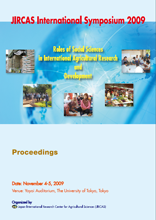Learning Sustainability of Agricultural and Rural Development from a Project in Indonesia: From the Point of View of Impact Assessment

The Indonesian government has improved agricultural development by aiming at
self-sufficiency in rice production since independence. Having attained this goal of
self-sufficiency in rice production, it has now adopted a policy shift to other agricultural outputs.
It examined the circumstances where some farmers in the rural society accepted paddy rice crop
technology and the production system in the developmental process of self-sufficiency in rice
production. Then, it tried to analyze the process in which traditional farmers who have not
experienced paddy rice cultivation in a Southeast Sulawesi province accepts paddy rice
cultivation. This report also examined under what kind of circumstances they would continue
paddy rice culture. That is, it determined what factors the traditional farmers had to consider in
accepting the paddy rice culture as a new agricultural method. It looked at the investment side
from the viewpoints of the change or no change factors of agriculture.
The JICA Cooperation activities in Indonesia included the implementation of an agricultural
and rural development project covering eight villages in this region as a model case between
1991 to1997. The project aimed to achieve a modest productivity increase over the current
level, through the development of a small-scale but effective agricultural infrastructure and
provision of operational guidance, rather than constructing large-scale facilities, based on the
bottom-up approach by encouraging the active participation of local farmers. In general, the
Tolaki traditional indigenous people consume both rice and sago starch as staple foods. Upland
rice is grown in a field of slash and burn and the people also go to the lowlands, engage in sago
starch extraction activity and enjoy food from sago starch. However, due to population pressure
and the corresponding increase in food demand, more land for upland rice production has
become a necessity. Therefore, shifting from the traditional farming to modern rice cultivation
was practiced. The eight targeted villages were mostly composed of Tolaki people. However,
some villages also have transmigrators from other areas. These transmigrators have experience
in paddy rice cultivation which they inherited from their ancestors. On the other hand, the Tolaki
people had never experienced paddy cultivation. The project focus was designed both to
introduce and promote paddy cultivation. The project was supported through technological
transfer, farm management and facility provision.
Successful technology transfer in agricultural and rural development relies on how the technologies are accepted by villages and how they contribute to the increase in the income and
improvement of rural living environment. Individual technologies are diversified in various
fields, such as increased production and life improvement, and these technologies must be
transferred directly to the farmers to obtain satisfactory results. Therefore, it is important to
establish a system to promote technology transfer. Upon project termination, paddy cultivation
had been carried out in the targeted villages, except in one village where assistance for paddy
cultivation was not provided. If this paddy cultivation will be continuously carried out by the
people, then the project would be evaluated as successful.
Ten years later, the project site was visited and evaluation was conducted. It was found that
six out of the eight villages continued practicing the production system and using the facility.
The facility was sustained in these villages because of the existence and support of the
transmigrants who were the originators of the paddy rice cultivation system. On the other hand,
the other two villages, where indigenous people mainly lived were not able to achieve
sustainability of paddy rice cultivation. Moreover, it was discovered that in one of the village of
the indigenous people, paddy rice cultivation continued to be carried out. However, in this
village, half of a paddy field was managed by the transmigrators and the paddy field was
expanded further. And paddy rice cultivation was performed briskly in the village in which
indigenous people and migration people lived in the four remaining villages. It can be said that
the sustainability of a paddy field from this was the influence of the migrants who have
traditional experience of paddy cultivation. A comparatively large river is near the village, and it
has a large flood plain in this riverside area. Many of villagers were growing field crops
extensively. Therefore, even if there is no paddy field, it is in a position where it can sustain
enough livelihoods. Moreover, in the B village, many farmers had an opportunity to work away
from home and obtain income easily in Kendari City which is close by. Indigenous famers said
that paddy rice culture had problems and difficulty compared with other crop cultivation
because group work was needed in the use of water, facility management and large initial
investment was also required. Therefore, when there was no additional economic merit as
compared to the existing agriculture, it became clear that sustainability was impossible. It can be
concluded that the needs for rice cultivation of two villages are limited because the rice yield is
low and the price is also cheap. In order for indigenous people to put on new
paddy-rice-cultivation technology and to make it sustainable, other important factors are
required such as they are of great necessity (needs) for the paddy fields of the farmers.
| Date of issued | |
|---|---|
| Creator | Yoshihiko Nishimura |
| Subject |
Agricultural and rural development Paddy rice production Sago farming Tolaki indigenous Technology transfer |
| Publisher | Japan International Research Center for Agricultural Sciences |
| Available Online | |
| Issue | 2009 |
| spage | 112 |
| epage | 125 |
| Rights | Japan International Research Center for Agricultural Sciences |
| Language | eng |
